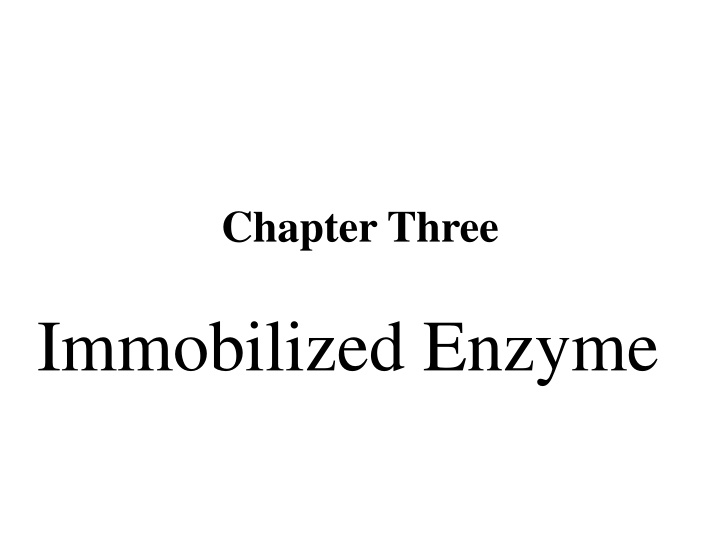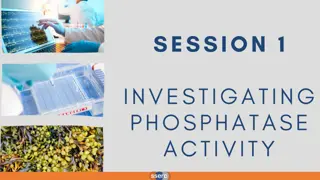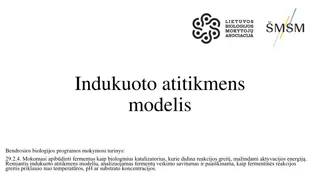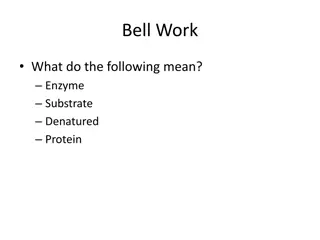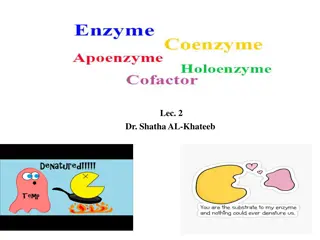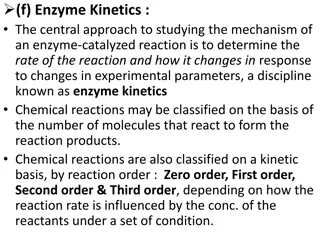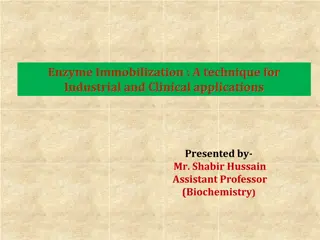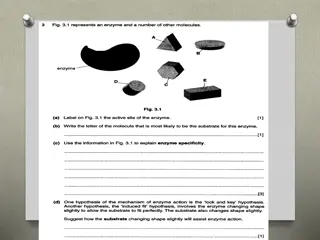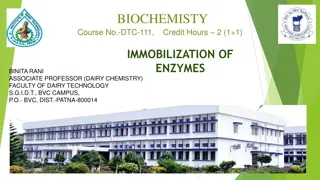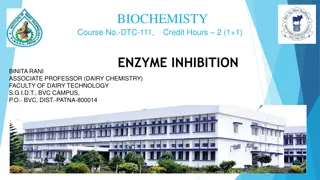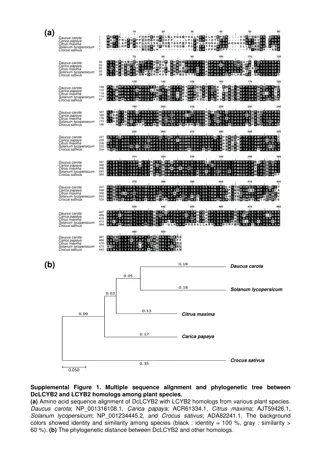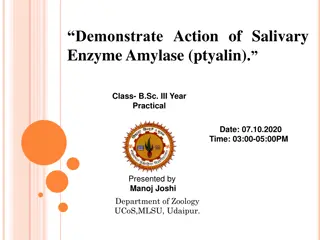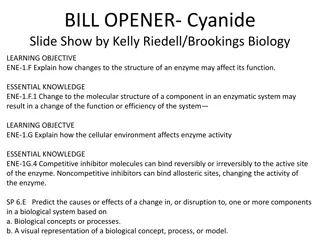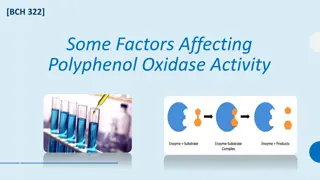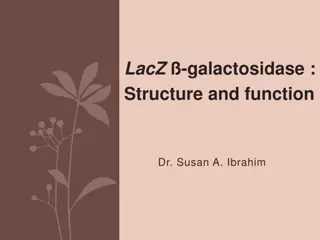Immobilized Enzyme
Enzyme immobilization is a crucial process in biotechnology to enhance enzyme stability and reusability. It allows for efficient separation of enzyme from products, reducing costs and increasing productivity. Various techniques, benefits, and criteria for successful immobilization are discussed in detail, emphasizing the importance of this method in industrial applications.
Download Presentation

Please find below an Image/Link to download the presentation.
The content on the website is provided AS IS for your information and personal use only. It may not be sold, licensed, or shared on other websites without obtaining consent from the author.If you encounter any issues during the download, it is possible that the publisher has removed the file from their server.
You are allowed to download the files provided on this website for personal or commercial use, subject to the condition that they are used lawfully. All files are the property of their respective owners.
The content on the website is provided AS IS for your information and personal use only. It may not be sold, licensed, or shared on other websites without obtaining consent from the author.
E N D
Presentation Transcript
Chapter Three Immobilized Enzyme
Content Introduction Immobilized Enzyme Immobilized Techniques Effect of mass transfer 2/14/2025 2
Introduction Enzymes are expensive, they should be utilized in an efficient manner As catalytic molecules, enzymes are not directly used up. After the reaction the enzymes cannot be economically recovered for re-use and are generally wasted This enzyme residue remains to contaminate the product and its removal may involve extra purification costs Simple and economic methods must be used to separate the enzyme from the reaction product 2/14/2025 3
Introduction Separation of enzyme and product using a two-phase system One phase containing the enzyme The other phase containing the product This is known as Immobilization 2/14/2025 4
Immobilized enzyme Enzyme immobilization is a process of confining the enzyme molecules to a solid support over which a substrate is passed and converted to products. 2/14/2025 5
Immobilized enzyme An immobilized enzyme is one whose movement in space has been restricted either completely or to a small limited region. 2/14/2025 6
Why Immobilize enzymes? Protection from degradation and deactivation. Re-use of enzymes for many reaction cycles, lowering the total production cost of enzyme mediated reactions. Ability to stop the reaction rapidly by removing the enzyme from the reaction solution Enhanced stability Easy separation of the enzyme from the product 2/14/2025 7
An ideal carrier matrices for enzyme immobilization Inert Physically strong and stable Cost effective Regenerable Reduction in product inhibition 2/14/2025 8
Immobilization criteria There are a number of requirements to achieve a successful immobilization: The biological component must retain substantial biological activity after attachment It must have a long-term stability The sensitivity of the enzyme must be preserved after attachment Overloading can block or inactivate the active site of the immobilized biomaterial, therefore, must be avoided 2/14/2025 9
Methods of enzyme Immobilization The three methods of enzyme Immobilization are: Entrapment(c,d) Surface immobilization(a,b) Cross linking 2/14/2025 10
Entrapment Entrapment is the physical enclosure of enzyme in a small space , simply trapped inside the polymer matrix. Enzymes are held or entrapped within the suitable gels or fibers. It is done in such a way as to retain protein while allowing penetration of substrate. Matrix entrapment and membrane entrapment, including microencapsulation, are the two major methods of entrapment. 2/14/2025 11
Entrapment - Matrix entrapment - membrane entrapment 2/14/2025 12
Surface Immobilization Adsorption Involves the physical binding of the enzyme on the surface of carrier matrix Carrier may be organic or inorganic. The process of adsorption involves the weak interactions like Vander Waal or hydrogen bonds. 2/14/2025 13
Surface Immobilization Covalent binding Retention of Enzyme on support surfaces by covalent bond formation The most widely used methods for enzyme immobilization Enzyme bind to support material via certain functional groups, such as amino, carboxyl, hydroxyl, and sulfhydryl groups 2/14/2025 14
Cross-linking Cross linking involves intermolecular cross linking of enzyme molecules in the presence/absence of solid support. 2/14/2025 15
2/14/2025 16
Comparison between the methods Adsorption Covalent coupling Entrapment Membrane confinement Characteristics Preparation Simple Difficult Difficult Simple Cost Low High Moderate High Binding force Variable Strong Weak Strong Enzyme leakage Yes No Yes No Applicability Wide Selective Wide Very wide Running problems High Low High High Matrix effects Yes Yes Yes No Large diffusional barriers No No Yes Yes Microbial protection No No Yes Yes 17
Advantage of immobilized enzymes Easy separation from reaction mixture, providing the ability to control reaction times and minimize the enzymes lost in the product Re-use of enzymes for many reaction cycles, lowering the total production cost of enzyme mediated reactions Ability of enzymes to provide pure products Possible provision of a better environment for enzyme activity 2/14/2025 18
Disadvantage of immobilized enzymes Increase the diffusion resistance, so decreases the reaction rate. Loss of activity upon immobilization. 2/14/2025 19
Immobilized enzyme reactor (example) Recycle packed column reactor - Allow the reactor to operate at high fluid velocities 20
Immobilized enzyme reactor (example) Fluidized bed reactor - A high viscosity substrate solution - A gaseous substrate or product in a continuous reaction system - Care must be taken to avoid the destruction and decomposition of immobilized enzymes 21
Immobilized enzyme reactor (example) - An immobilized enzyme tends to decompose upon physical stirring. Continuous stirred tank reactor - The batch system is generally suitable for the production of rather small amounts of chemicals. 22
Effect of mass transfer resistance The immobilization of enzymes may introduce a new problem which is absent in free soluble enzymes. mass-transfer resistance is present due to the large particle size of immobilized enzyme due to the inclusion of enzymes in polymeric matrix. Schematic diagram of z path of the substrate to z reaction site an immobilized enzyme 2/14/2025 23
Effect of mass transfer resistance If we follow the hypothetical path of a substrate from the liquid to the reaction site in an immobilized enzyme, it can be divided into three steps. 1. Transfer from the bulk liquid to a relatively unmixed liquid immobilized enzyme 2. Diffusion through the relatively unmixed liquid layer 3. Diffusion from the surface of the particle to the active site of the enzyme in an inert support layer surrounding the 2/14/2025 24
Substrate HIGH Sb Immobilized Enzyme Low S concentration DIFFUSION DRIVING FORCE
HIGH Sb Immobilized Enzyme REACTION DIFFUSION DRIVING FORCE PRODUCT
HIGH Sb Immobilized Enzyme DIFFUSION DRIVING FORCE
HIGH Sb Immobilized Enzyme REACTION PRODUCT
Effect of mass transfer resistance Mass transfer resistance are divided into two: External mass transfer resistance (during transfer of substrate from the bulk liquid to the relatively unmixed liquid film surrounding the immobilized enzyme and during diffusion through the relatively unmixed liquid film) Intra-particle mass transfer resistance (during diffusion from the surface of the particle to the active site of the enzyme in an inert support 2/14/2025 29
External mass transfer resistance Assumption Enzymes are evenly distributed on the surface of a nonporous support material All enzyme molecules are equally active Substrate diffuses through a thin liquid film surrounding the support surface to reach the reactive surface The process of immobilization has not altered the enzyme structure and the M-M kinetic parameters (rmax, KM) are unaltered Ss Sb Enzyme Liquid Film Thickness, L 2/14/2025 30
External mass transfer resistance Diffusional mass transfer across the liquid film: JS = kL (CSb CSs) Ss Sb liquid mass transfer coefficient (cm/s) substrate concentration in the bulk solution (mol/cm3) substrate concentration at the immobilized enzyme surface (mol/cm3) kL CSb CSs Enzyme Liquid Film Thickness, L 31 2/14/2025
External mass transfer resistance At steady state, the reaction rate is equal to the mass-transfer rate Ss Sb = maximum reaction rate per unit of external surface area (e.g. mol/cm2.s) is the M-M kinetic constant (e.g. mol/cm3) Enzyme Liquid Film Thickness, L 2/14/2025 32
External mass transfer resistance The above equation can be expressed in dimensionless form as: 2/14/2025 33
Damkhler number (NDa) If NDa >> 1, rate of diffusion is slow and therefore it is limiting, the overall rate of reaction is controlled by: rp = JS = kL (CSb CSs) If NDa << 1, rate of reaction is slow and therefore it is limiting, the overall rate of reaction is controlled by: If NDa = 1, rates of diffusion and reaction are comparable 2/14/2025 34
Effectiveness factor () To measure the extent which the reaction rate is lowered because of resistance to mass transfer: Effectiveness factor is a function of and C Ss 2/14/2025 35
Intra-particle mass transfer resistance Assumption: Enzyme are uniformly distributed in spherical support particle. Substrate diffuses through the tortuous pathway among pores to reach the enzyme Substrate reacts with enzyme on the pore surface Diffusion and reaction are simultaneous Reaction kinetics are M-M kinetics 2/14/2025 37
Intra-particle mass transfer resistance Under internal diffusion limitations, the rate per unit volume is expressed in terms of the effectiveness factor as follows: maximum reaction rate per volume of the support M-M constant substrate concentration on the surface of the support effectiveness factor 2/14/2025 38
Intra-particle mass transfer resistance Definition of the effective factor For < 1, the conversion is diffusion limited For = 1, the conversion is limited by the reaction rate 2/14/2025 39
2/14/2025 40
Group project(3/4) Industrial Bioprocess 1.Production of yoghurt 2.Cheese production 3.Production of Acetic acid 4.Ethanol production 5.Beer production 6.Production of High Fructose Syrups 7.Wine production 8.Glutamate production 9.Lysine production 2/14/2025 41
cont... 10. Production of Penicillin 11. Production of Bakery yeast 12. Citric acid production 13. Lactic acid production 14. Vitamin C production 15. PLA production 16. Propanediol production 17. Biodiesel production 18. Production of butter 19. Xanthan gum production 2/14/2025 42
